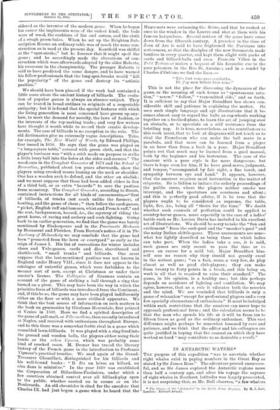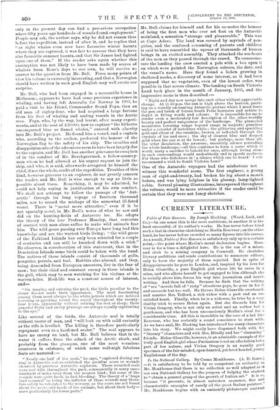IN ANTARCTIC WATERS.*
THE purpose of this expedition "was to ascertain whether right whales exist in paying numbers in the Great Bay as stated by Sir James Ross." The adventure proved unsuccess- ful, and as Sir James explored the Antarctic regions more than half a century ago, and after his voyage the capture of right whales in Southern latitudes was largely prosecuted, it is not surprising that, as Mr. Bull observes, "a few whalers • The Cruise of the • Antarctic' to the South Polar Seuione. By H. J. Bull. London : Edward Arnold.
only in the present day can find a precarious occupation where fifty years ago hundreds of vessels found employment." People may ask, the author says, why he did not reason thus before the expedition, instead of after it, and he replies that "as right whales even now have favourite winter haunts where they are captured, it was fair to assume that they have also favourite summer haunts, and that Sir James had lighted upon one of them." If the reader asks again whether this assumption was not likely to have been made by scores of whalers from Ross's days to our own, he will receive no answer to the question from Mr. Bull. From many points of view his volume is extremely interesting, and that a Norwegian should have written in such good English may well excite our surprise.
Mr. Bull, who had been engaged in a mercantile house in Melbourne, appears to have bad some previous experience in whaling, and having left Australia for Norway in 1893, he paid a visit to his friend, Commander Svend Foyn, then an old man of eighty-four, who had acquired a large fortune from his fleet of whaling and sealing vessels in the Arctic seas. Foyn, who, by the way, had learnt, after many experi- ments, and at the cost of R20,000, bow to capture " the hitherto unconquered blue or finned whales," entered with alacrity into Mr. Bull's project. He found him a vessel, and a captain who, according to the author, preferred the honour of the Norwegian flag to the safety of his ship. The troubles and disappointments of the adventure seem to have been largely due to the captain, and Mr. Bull has another grievance to complain of in the conduct of Mr. Borchgrevinck, a fellow-country- man whom he had allowed at his urgent request to join the ship, and who, it is said, afterwards arrogated to himself the chief, if not the whole, credit of the expedition. Troubles of this kind, however grievous to an explorer, do not greatly concern the reader, and Mr. Ball is wise enough to say as little as possible about them. Something, it may be admitted, he could not help saying in justification of his own conduct.
We shall not attempt to follow the passage of the 'Ant- arctic' through its long voyage of fourteen thousand miles, nor to record the mishaps of the somewhat ill-fated vessel. There is " metal more attractive," even if it be not specially novel, in Mr. Bull's notes of what he saw and did on the hunting-fields of Antarctic ice. He adopts the theory of the late Professor Moseley, that centuries of contact with man alone suffice to make wild animals fear
him. The wild geese passing over Europe have long had this knowledge and are the wariest birds living ; "the wild goose of the Falkland Islands has only been schooled for a couple of centuries and can still be knocked down with a stick." He observes, in corroboration of this statement, that in the Desolation Islands some birds could be taken with the hand. The natives of those islands consist of thousands of gulls, penguins, petrels, and teal. Rabbits also abound, and they, being descended from European ancestors, live in the fear of man ; but their chief and constant enemy in these islands is the gull, which may be seen watching for his victims at the warren-holes. Bird-life was a constant source of interest, and- " On nearing and entering the pack, the birds peculiar to the closer floe-ice made their appearance. The most fascinating among them must always he the white petrels which are noticed hovering or gyrating round the vessel throughout the twenty- four h'urs, apparently without retiring for rest or sleep; their graceful flight and snowy plumage are always equally captivating to the eye."
Like several of the birds, the Antarctic seal is totally without terror of man, and "will look on with mild curiosity as the rifle is levelled. The killing is therefore particularly repugnant even to a hardened sealer." The seal appears to have no enemy on land, but Mr. Bull believes that in the water it suffers from the attack of the Arctic shark, and probably from the grampus, one of the most voracious creatures in existence, of which some well-nigh fabulous feats are narrated :-
" Nearly one half of the seals," he says, " captured during our stay in Antarctic waters exhibited the peculiar scars or wounds observed by previous Antarctic explorers. These wounded seals were net with throughout the pack, consequently in many cases hundreds of miles away from the nearest land ; but some of the wounds were quite fresh, in fact bleeding. The theory of a `huge land mammal' as being the inflictor of these wounds may there- fore safely be relegated to the nursery, as the scars are not found about the necks and heads of the animals, but about their body— more particularly the lower parts."
Mr. Bull claims for himself and for his co-mates the honour of being the first men who ever set foot on the Antarctic mainland, a sensation "strange and pleasurable." This was at Cape Adare. The land was covered by myriads of pen- guins, and the confused screaming of parents and children is said to have resembled the uproar of thousands of human beings in an excited assembly. They attacked the sea-boots of the men as they passed through the crowd. To commemo-
rate the landing the crew erected a pole with a box upon it on which were painted the Norwegian colours, the date, and
the vessel's name. Here they found a lichen growing in sheltered nooks, a discovery of some interest, as it had been supposed that no vegetation, even of the lowest order, was possible in that severe climate. The landing on South Victoria Land took place in the month of January, 1895, and the impressive scene is thus described:-
" Night and day now merge into each other without appreciable change. At 11.30 p.m. the sun is high above the horizon, paint- ing us a weirdly enchanting Antarctic picture which I must leave the pen and brush of future South Polar laureates and artists to depict in fitting words and colours. It is impossible for me to render even a moderately fair description of the other-worldly beauty and perfect uniqueness of the landscape. The pinnacled mountains towering range beyond range in majestic grandeur under a coverlet of matchless white ; the glittering and sparkling gold and silver of the sunshine, broken or reflected through the crystals of ice and snow ; the sky of clearest blue and deepest gold when the sun is at its lowest; but perhaps, more than all, the utter desolation, the awesome, unearthly silence pervading the whole landscape,—all this combines to form a scene which i ; worth many a sacrifice to behold for once, although living alone in such surroundings would undoubtedly end in speedy madness. For those who disbelieve in ' a silence which can be heard' I will recommend a visit to South Victoria Land."
One of the Antarctic voyagers had the misfortune not witness this wonderful scene. The first engineer, a young man of eight-and-twenty, had broken his leg about a month before, and was lying helpless in his gloomy, lamp-lighted cabin. Several pleasing illustrations, interspersed throughout the volume, would be more attractive if the reader could be certain that they were not fancy sketches.



















































 Previous page
Previous page